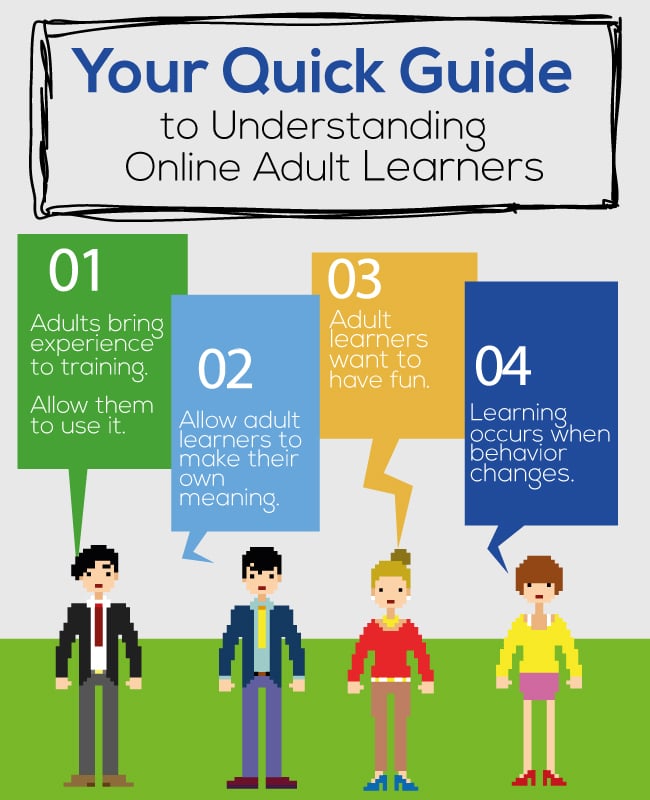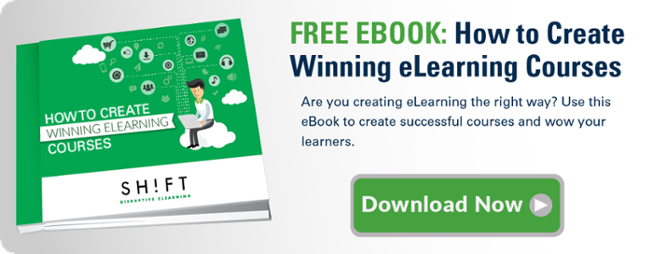Everyone learns a little bit differently. Some people excel with visual information while others have to hear or write something down for learning to stick. Just like each person has a learning style, groups have learning styles as well, especially adult learners.
This distinct group of learners, adults, responds best to eLearning when course designers keep their specific learning needs in mind. Great eLearning for adults needs to take cues from pioneers in adult learning such as Malcolm Knowles and Bob Pike. Both men recognize that adults learn in specific and different ways than traditional college students and other learners.
Understanding Pike's Principles of adult learning leads to more successful eLearning courses.

1) Adults bring experience to training. Allow them to use it.
Adults come to learning with a broad range of experiences under their belts. They are workers, spouses, parents and have a wealth of knowledge based upon these experiences.
Effective eLearning for adults recognizes, respects and capitalizes on the knowledge they bring to the table. Try including experiential techniques such as:
- Discussions;
- Real life case studies;
- Problem-solving games;
- Or manipulating scenarios with multiple variables.
These activities allow adult learners to draw from past experiences and engage them in hands on learning. They will allow them to be active participants in the learning experience (after all that's what they prefer).
2) Allow adult learners to make their own meaning.
Or as Pike puts it, people don't argue with their own data. Adult learners are far more likely to invest in an idea when they generate an idea themselves either from their experiences or from information presented in the course. Interactive learning tasks also capitalize on adult learners' desires to share what they know, validate their experiences, and acquire knowledge through practical activities. After all, learning is enhanced if we give students a chance to reflect, review, and personally relate to the material and how they might apply it.
To structure adult learning in this manner, try:
- Having the learners compile a list of effective strategies to address an issue;
- Presenting data and asking the learners to draw conclusions about its meaning;
- Or creating a list of tangible ideas they can put to use immediately.
By creating their own data and arriving at their own conclusions, adult learners are more likely to internalize the learning concepts.
3) Adult learners want to have fun.
Humor, laughter, and games bring joy and fun to eLearning for adults who usually have very little free time among their many obligations for professional development or personal learning.
Humor doesn't mean silly, though. It does mean offering a satisfying and joyful learning experience. Inserting the “fun” element in your content can help reducing stress and anxiety, especially when it comes to learning. And a more relaxed environment means more openness to learning.
eLearning course designers should look for ways to build excitement and community among participants, provide challenges and rewards, and incorporate games and creative activities. Use humor only in the context of the learning. In other words, the humor must relate to your content.
4) Learning occurs when behavior changes.
No learning is successful if it doesn't result in a change in the learner's behavior. Or as the The Law of the Learning Process says: “Learning does not take place until behavior is changed". It is not simply a matter of showing that you can do it but of demonstrating to them that they can do it.” Changing behavior, though, takes time even when the learning is relevant, useful and engaging.
To change behavior, provide learners multiple opportunities to apply new knowledge and skills within the course. In other words, you need to create learning environments that give learners a chance for practicing. This will increase the likelihood of retention and on-the-job application. Applying the information in a non-threatening environment provides learners with chances to see how new ideas can work successfully.
Planning for adult learning is different than planning courses for new college students or high school students. They have different needs and bring a different mindset to the course. Understanding the key ideas behind how adults learn can lead to more successful courses.




